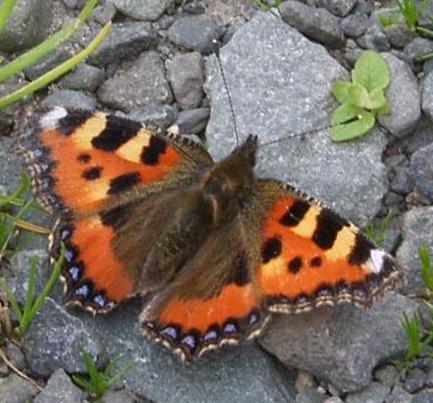Small Tortoiseshell Butterfly
Scientific name: Aglais urticae

The Small Tortoiseshell (Aglais urticae) is one of the commonest British butterflies easily recognised with its bright orange and black wings, and the edge of D-shaped blue spots on the fore and hindwings. The undersides are a bit like a sepia tint image of the uppersides and help it to blend with its surroundings as it roosts. The pattern on the forewing could be mistaken for that of the Painted Lady Butterfly, but the latter is larger and does not have the blue spots. As with most butterflies the male is smaller than the female with a wingspan between 45 and 60mm.
The adults emerge in the spring and seek out a food source where the males defend a territory, but they will move on after a few hours if no mate shows up. When a female is encountered there follows a chase which ends with them mating. The eggs are layed on stinging nettles. The caterpillars are black with yellow lines along the body and hairy spines which give some protection from predators. They reach about 22mm in length before metamorphosing into a chrysalis, which can often be found hanging under a window sill.

Small Tortoiseshell caterpillars on the right with yellow lines - the black one on the left is a Peacock Butterfly caterpillar
Some adults may emerge prematurely during mild periods in the winter. The majority are seen from March to June and the new generation, from mid-July to late September when they can be seen feeding on Budleja, Thistles and other nectar-rich flowers as they stock up for winter hibernation.
The numbers of the Small Tortoise have fallen by as much as 80% in the last 20 years in parts of the British Isles. This is thought to be due to a parasitic fly which has moved here from southern Europe. First recorded in 1999, the Sturmia Bella Fly lays its eggs in the butterfly caterpillars. Adult flies emerge from the chrysalis.
Back to GARDEN CREATURES